I write this coming down from what can only be described as an epic sugar high.
While few words are more abused than “epic,” it applies here, for this happened on Saturday:
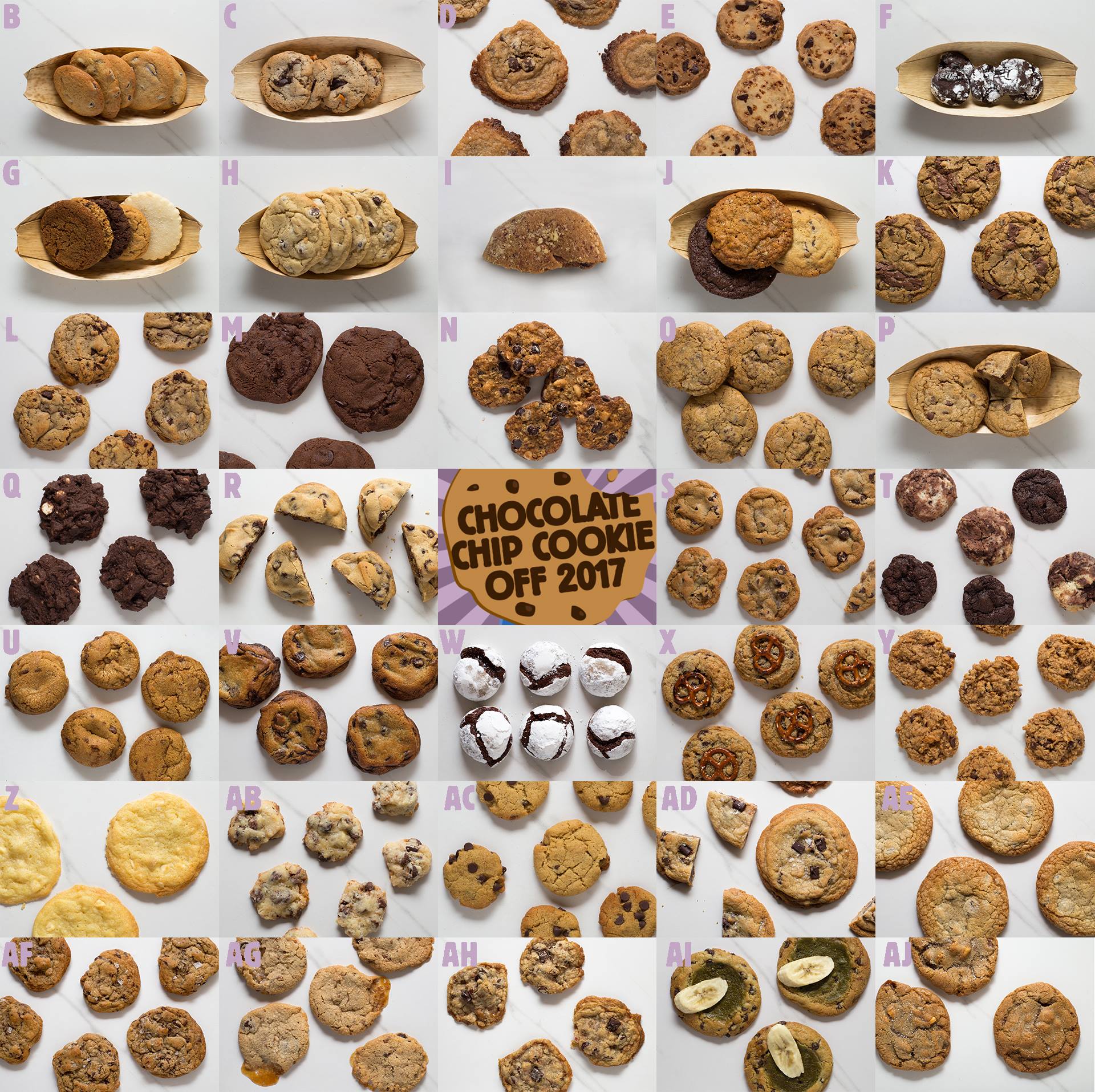
You are looking at the cookies for Chocolate Chip Cookie Off 2017 (henceforth: CCCO2017), the sequel to the original Chocolate Chip Cookie Off.
Ante up
While the original featured 18 cookies and no professionals, this one featured 34 cookies and over 27 professional bakers and chefs.
Most importantly, we were able to morph this into a charity event. The Henley Room, a beauty of a venue, was provided free-of-charge. Every professional donated their time and expertise. SOMA Chocolate (my favorite chocolate store) chipped in with their amazing hot chocolate. Collectively, we raised $2500 for the United Way, and all the excess cookies went off to a women’s shelter.
The entire night comprised of me having a shit-eating grin on my face. People give lip service to enjoying life and making things happen, but this was it.
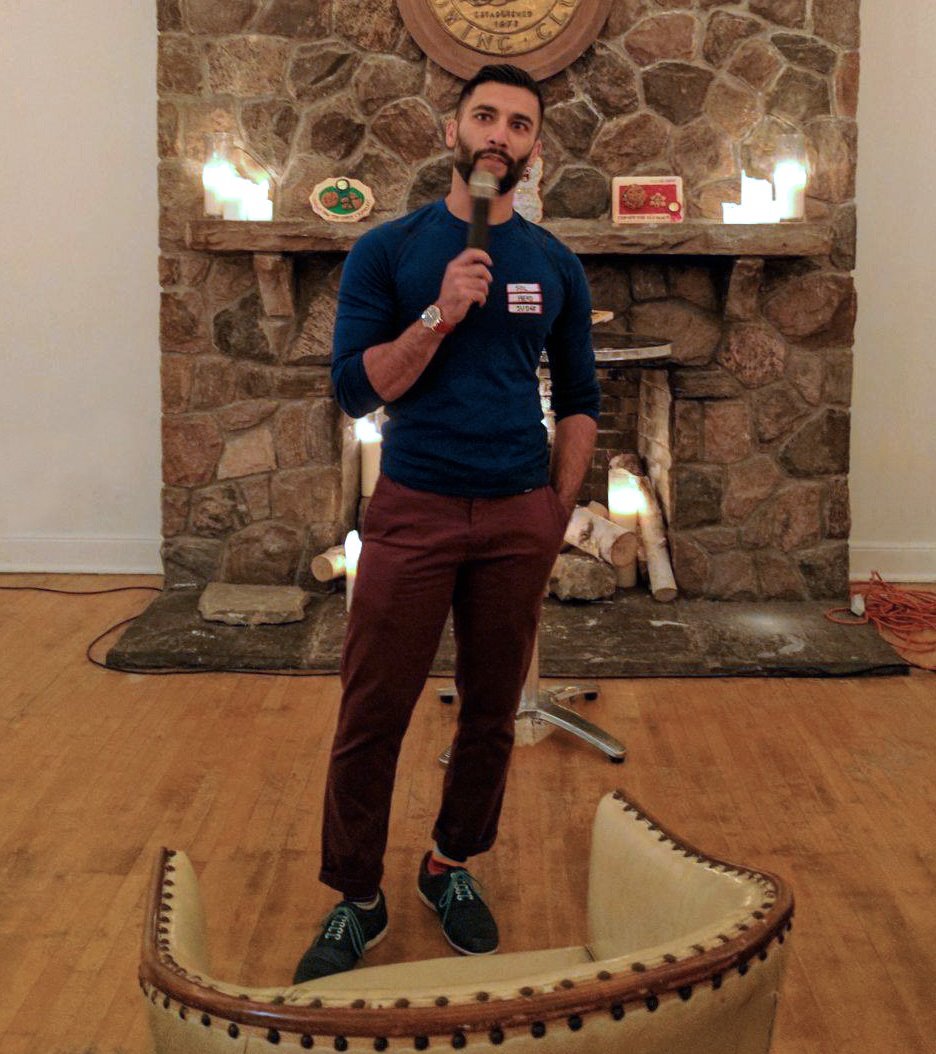
Here were 140 adults, all coming together to feast on a smorgasbord (nay: a plethora!) of chocolate chip cookies. It’s incredibly freeing to throw away responsibility for one night and be able to indulge, socialize, and just have plain fun.
Here’s the list of professionals who made cookies:
- Rocco from Pizzeria Libretto
- Nick from Porchetta & Co
- Alex Tso from Dundas Park Kitchen
- Jen from Pretty Sweet
- Shai from Sweet&Shy
- Elie from The Red Bench
- Jeff from SCHOOL
- Eden from New Moon Kitchen
- Craig of Craig’s Cookies
- Rose of Rosie’s Eatery
- Johanna of Good & Best Cookie Company
- Clair from Life is Sweet
- Elyse from Sullivan & Bleeker
- Lisa from Le Dolci
- Christinn of Millie Desserts
- Milton of Le Gourmand
- Alan from CookieDelivery.ca
- Davis from Dufflet
- Jason from U-Feast
- The Rolling Pin (could not attend, sent cookies)
- ShopBake (could not attend, sent cookies)
- Tre Mari Bakery (could not attend, sent cookies)
- Montmartre Bakery (could not attend, sent cookies)
- Bobbette & Belle (could not attend, sent cookies)
- Phipps Bakery (could not attend, sent cookies)
- The Food Dudes (could not attend, sent cookies)
- Detroit Cookie Company (mailed in)
That is 27 professionals!!! (yeah, I just used triple exclamations)
Here’s the real crazy part: I had only met six of these people before this event.
People see these events and think they require some deep connections or magic. Nope. You can easily do the same (ideally do them in Toronto so I can attend too).
I am going to take you step-by-step on how I was able to get so many amazing people
—
Background
I’ve been meaning to write about the #cookielife, so we’ll save that for another day. The quick version is some trash talking between friends over what was the best chocolate chip cookie in Toronto resulted in the original Chocolate Chip Cookie Off. When people told me they could make better cookies, I responded with a “prove it.” As they proved it (by sending me cookies in the mail), this spawned the #cookielife.
The #cookielife is so bananas now that people tag me when their friends make cookies and go “you should send Sol cookies.” And they do!
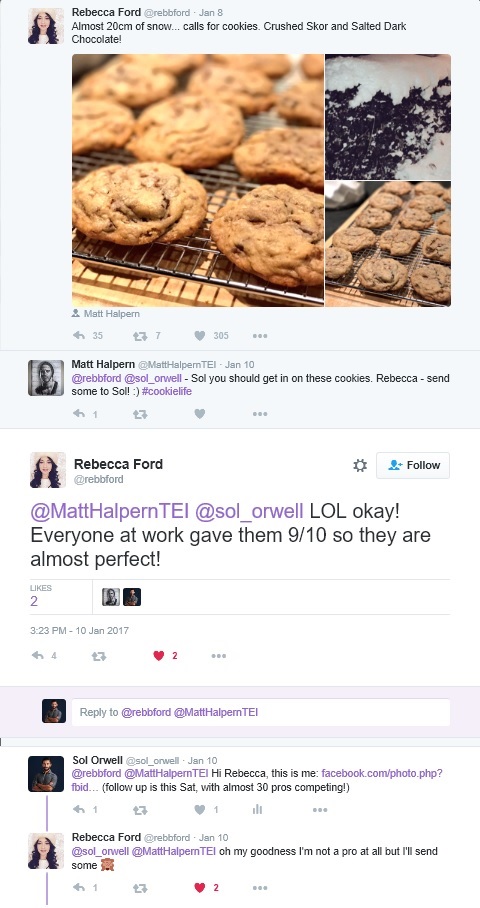
Subsequently, because of this trash talk, we’ve ended up doing a pie-off, a mac n’ cheese off (I won with a delightful lobster mac n’ cheese baked in a crust and topped with a bacon weave), an ice cream crawl, and other ridiculous food fests.
One thing I have been very particular with the #cookielife and all these food feasts is to keep them ad-hoc. I have resisted all well-intentioned recommendations to start an Instagram account, to make a website, to make it a brand. What people don’t realize is that it’s very magic is because it’s just thrown together and somehow works. The #cookielife was never about building a brand about it or me – it was always about just having fun.
The very ad-hoc nature of #cookielife became important when convincing others to join in
—
Vision
I knew what the goal was. I wanted people who love chocolate chip cookies. And I wanted individuals who were fun and enjoyable to hang out.
That was it. I didn’t care about anything else: how many followers you had, how “important” you were, or anything else. I only invited people I would want to sit down with and have a cookie and coffee.
To make it truly meaningful, I also wanted to connect this with charitable giving. It became a no-brainer to have people who weren’t making cookies to donate to eat all these scrumptious cookies.
It was all about the human connection here.
This vision is necessary because when contacting the professionals, it let me convey precisely what I was trying to do; it guided my communications with them.
Have clear-cut vision on what you want. It helps guide everything you do
—
Research
Roughly ten weeks before CCCO2017, I started looking around for the best chocolate chip cookies in Toronto. I googled. I asked friends. I asked on Twitter. I looked it up on various blogs.
I threw all of that into a spreadsheet. The columns were:
- Name
- Person’s name
- Person’s Facebook, Twitter, and LinkedIn (if I were on Instagram, would have included that)
- Status?
- Reminded
- Mutual Friends
- Notes
As I went through lists of best chocolate chip cookies, I added them to the spreadsheet. I filtered off the bat – if they made no chocolate chip cookies, or were not really in Toronto, or seemed meh, I did not add them.
Once I had exhausted all possibilities, then came the hard work. I researched every single business and looked up who was behind it. If I was going to ask someone to make cookies, I had better know who they were!
Researching each bakery or cafe was critical
This research took up a lot of time. It was a slow and manual process. People in the food industry can be hard to find, especially bakers and pastry chefs. And it’s important that when you contact them, you do it right.
For example, Mabel’s Bakery is one of the best bakeries in Toronto. But the owner is Lorraine, as the name Mabel comes from her grandmother.
A perfunctory glance would have had me think “oh yeah, it must be Mabel” who owns it. Any subsequent emails with “Hello Mabel” would just make me look like a nitwit.
Furthermore, when I contacted them, I wanted to do it in a way that they understood I had looked into their work, not used them as a quick grab for cookies!
I ended up with roughly 75 names. It took me around 35 hours to collect all this information.
I need to repeat this. It took me 35 hours of research to look up 75 people.
This is not work you can automate.
This is not work you can outsource.
This is not work you can skip.
This is not work you can do quickly
This is critical work that gives you information that lets you really connect with a person.
I spent a lot of time reading about these bakers. For example, one got started after losing her home and decided if she was getting a fresh start at home, she may as well professionally to it. Another did it to be an inspiration to their kid; that her daughter could be anything she wanted.
Each person has a unique story, and if you don’t understand a facet of it before you contact them, to me, you’re just wasting everyone’s time.
I recently vented on Facebook on how many people are just terrible at connecting. One big article I’ll have coming up in the next few months in how to network right.
The goal here isn’t to solicit. The goal is to show them you are on the same wavelength as them.
—
Leverage your network
My network was a huge boon for this. My buddy Jayson is great at this, asking his friends for help. Look at all the comments when he asked for a backpack recommendation.
Thus, I posted this:
You can see in the comments a few people tagged their friends, and voila – awesome people (which remember, is the real point of this) were intrigued.
A few of the recommended bakers were already on my list. A personal vouching made it a lot easier 🙂
Ask your friends for help
—
Hi, I’m Sol.
The next step was to contact them and let them know about this awesome event we were planning.
People are just terrible at cold emails, usually either rambling or just going for the pitch.
Here is the general structure I used:
- Who I am (show you I’m worth your time and not a crazy person)
- What we’re about to do (cookie off! And we’ve done this before)
- What our goal is (have fun, enjoy “adulting,” and raise money for charity)
- ASK (what’s the point if you don’t explicitly ask what you are looking for)
I also ensured that each email was tailored specifically for them. Some of the bakers I knew were a bit more serious, so I was a bit more staid. Others I knew were fun-loving, so I let loose.
Remember how I looked up Facebook and LinkedIn? If we had mutual friends, I would ask the mutual friend if it was ok I namedrop them. Being able to say “I also saw you’re friends with Joe. Joe is gonna try to come to CCCO2017” helped convert me from a stranger to a second-degree connection.
And if I was close with the mutual friend, I straight up asked for an introduction.
I never ever namedropped without asking someone first. This is a giant no-no, and I’ve seen far too many people do it.
People talk, and reputations matter; the last thing you want is to have people think you’re underrated
I then dutifully updated my spreadsheet, saying that I had contacted them (Status: Contacted)
Structure your email to show your value and what you’re asking for, and use your mutual friends when it makes sense
—
Follow Up!
Listen – people are busy. Their inboxes are often a wasteland. If you don’t get a reply, it’s a smart idea to follow up.
One secret to a good follow up: always bring something new to the table.
A few weeks in, I sent an email saying “oh – hey, not sure you read my email. We now have 15+ pros committed, and we’re estimating 75-100 people, with a mix of 50% entrepreneurs, and 50% restaurant/foodies.”
If they had Twitter, I also tweeted at them. Just a simple message saying hey sent an email, would love to hear back.
Pro-tip: see if they reply to tweets. If they don’t, I didn’t bother.
Don’t just send one email and forget it. Follow up a few times
—
People responded
My response rate from the original email was roughly 50%, and by the second email, I came out to around 66%.
I have sent a lot of cold emails, and I’d say my overall response rate is above 50%. It’s not hard – it just takes time.
My cold emails got a 66% response rate.
—
Best (Facebook) Friends Forever!
People think the hard part is getting the yes…
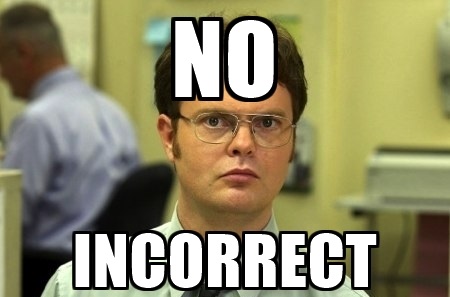
The hard part is making it happen. I’m a pretty optimistic person, but in stuff like this, I never count my chickens until they hatch.
What I did was create a Facebook event, and then invite all the bakers. This would allow me to stay in touch with them without overwhelming their email inbox (I was also driven by the selfish desire to befriend people who make delicious things)!
So I let most of them know I would be adding them to Facebook to invite them to the event.
The bonus is they got to see how I interacted via my own Facebook and saw that yeah… Sol really really loves cookies.
I like to build a personal connection through Facebook. It lets see people who I am
On a side note: having my Facebook feed be an oddball mix of local friends, fitness, entrepreneurship, web development, internet marketing, and the food industry is endlessly fascinating to me. It’s a weird look into so many different worlds, all of which operate without a care for the other.
—
Don’t let them forget
The last step was to keep everyone updated.
I sent an email out a few weeks before the event wishing each person a happy new years, and then included details on how the competition would run.
I sent out an email about a week before saying… it’s coming!
Finally, I sent out an email three days before just reminding everyone the rules and some frequently asked questions.
In this entire time, only two bakers dropped out. And they did so because of personal reasons, and still sent us cookies!
All of these emails? I sent manually. I’m an old-school kind of guy, but, spending the time do it right ensures you get the response you want.
Trust me, confirm the plan
—
The Chocolate Chip Cookie Off 2017
I had never hosted an event before, and the Chocolate Chip Cookie Off 2017 was way bigger than I anticipated. When I first started, I expected 30 competitors, 75-100 people, and $1000-1500 raised.
We ended up with 34 competitors, 140 people, and $2500 raised.
Click here if you want to see the pictures and who the winners were.
Overall, it seems like people had a grand ole’ time. It was an absolute pleasure to have participated in something as audacious as this. Mission accomplished.
—
The Aftermath
Oh boy was I sore the next day. I did not sleep much that night; I was jacked up on adrenaline from the event itself, compounded by my mind churning over all the little mistakes we committed.
Thus, I did two things on Sunday:
- I recorded a simple video thank you to each competitor. I thanked them, told them about the money we were able to raise, how everyone who attended had a blast, and that I hope to see them come back next time.I got this idea from buddy Jayson, and Vidyard’s viewedit makes it incredibly easy. The bakers donated their time and the cost of goods to come to this attend. It was the least I could do.
- I documented every little flaw or mistake we committed.
I then used this list to create a playbook for next time. Everything I’ve learned, distilled into one easy-to-read document so that next time is 10x smoother.
(One of my upcoming articles will cover mining hindsight to improve)
Two days ago, I posted a collage of all the cookies and all of the cookie-makers. People loved it, and I hope it drives more customers and positive reviews to each baker.
—
And that’s how I got 27 professionals to make cookies
Read this through, I hope you’re left with one thought:
“there’s no secret; I could do this!”
I didn’t have some giant Rolodex. I didn’t offer them eFame or money. I reached out as a fan of cookies, explained the vision I had, and asked them to join.
Some declined. Some ignored me. But enough awesome people reached responded that the event was a huge success. We raised a decent chunk of change. We all had a lot of fun.
The focus should always be on the human connection.
That was the “secret” sauce.
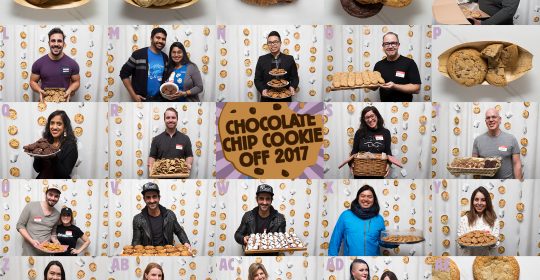
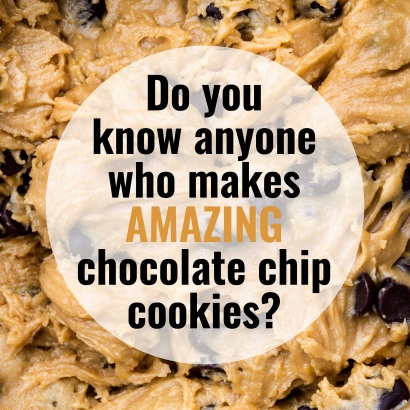
Leave a Reply